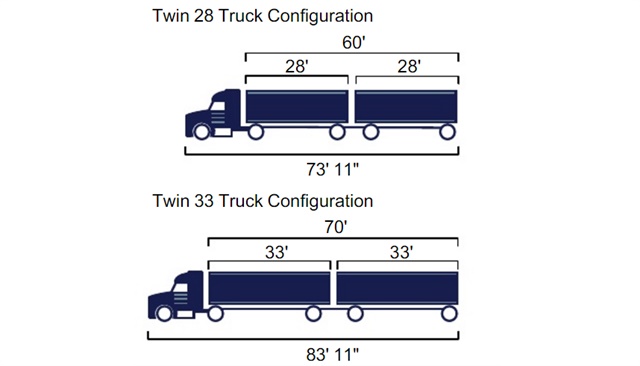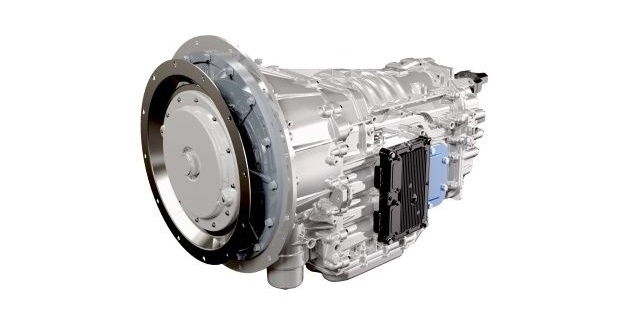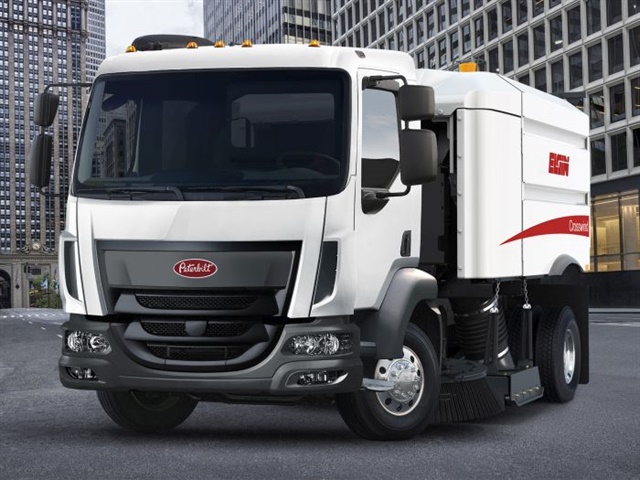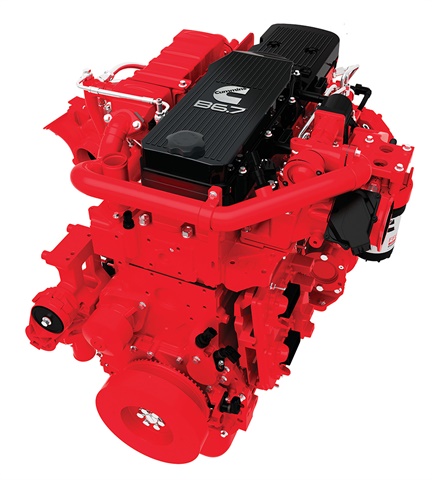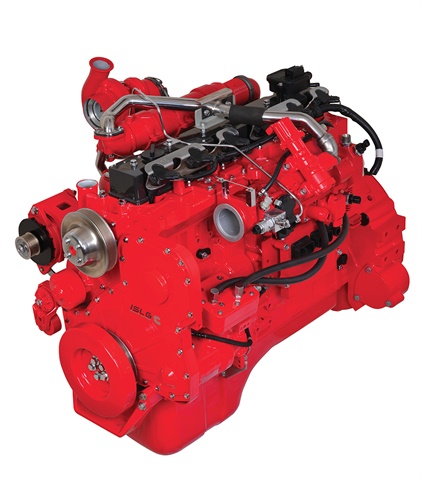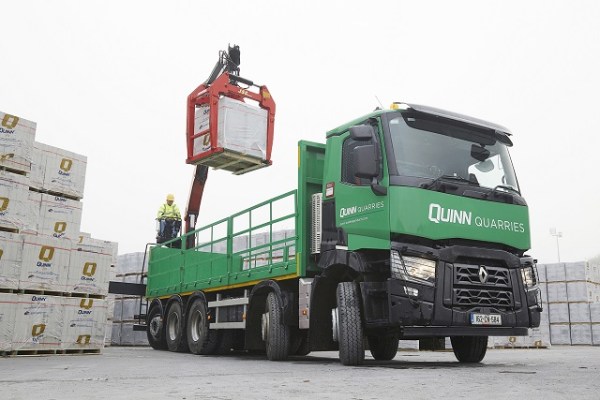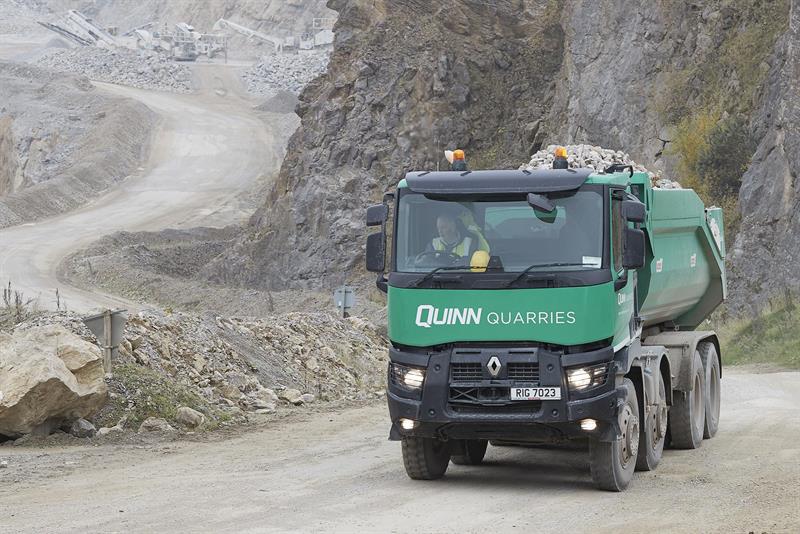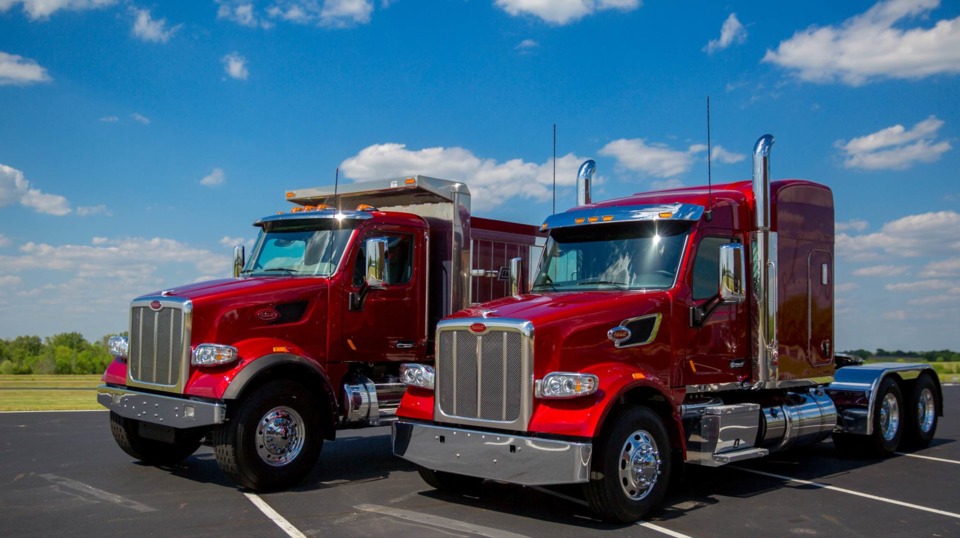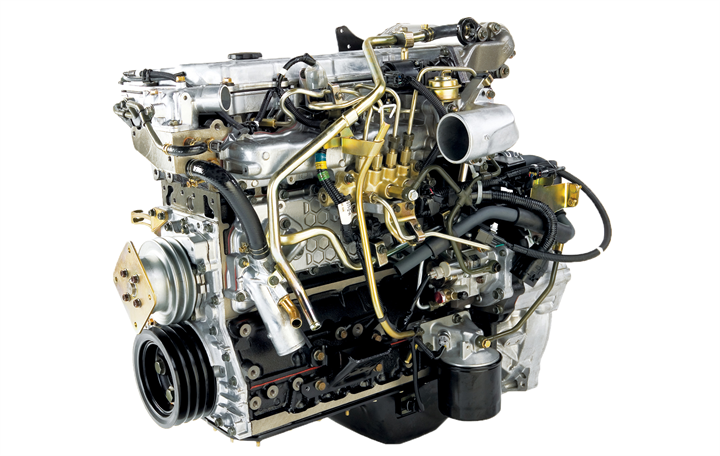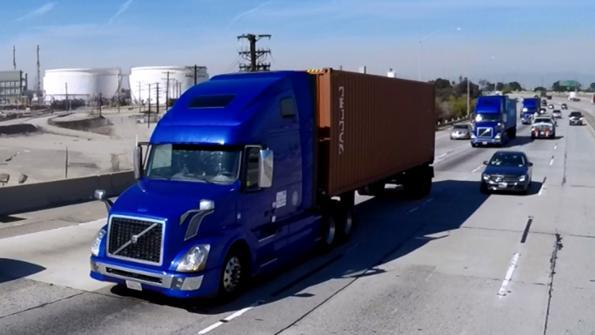
kscarbel2
Moderator-
Posts
17,893 -
Joined
-
Days Won
86
Content Type
Profiles
Forums
Gallery
Events
Blogs
BMT Wiki
Collections
Store
Everything posted by kscarbel2
-
Infrastructure Reform Group Finds Twin 33s Boost Safety and Efficiency Heavy Duty Trucking / March 14, 2017 The Americans for Modern Transportation coalition released a new study finding that twin 33-foot trailers would boost safety and efficiency with widespread adoption. The study, entitled Twin 33 Foot Truck Trailers: Making U.S. Freight Transport Safer and More Efficient, was conducted by Ronald Knipling, a 35-year traffic safety researcher. In it, Knipling found that twin 33s improved safety primarily through road stability and cutting down on the number of trucks on the road. Because trailers often fill up before hitting the 80,000-pound limit, according to the study, by switching from twin 28-foot trailers to twin 33s, cargo volume could increase by 18.6% while still not needing to increase the maximum weight limit. This means that using twin 33s would require 15.7% fewer trucks and trailers to carry the same amount of cargo. “Allowing widespread use of Twin 33 trailers is common sense policy. Not only are they more stable at highway speeds, the efficiency gains mean we have fewer trucks on the road,” said Knipling. “Fewer trucks means fewer accidents, less wear and tear on our roads, and more focused enforcement by weigh stations for all types of trucks. It’s a win-win for drivers, consumers, businesses, and the economy.” The study found that through a widespread adoption of Twin 33s, truck miles driven could have by reduced by as much as 3.1 billion miles and reduced the number of truck-involved accidents by 4,500 annually. Fewer trucks on the road would also reduce fuel use, saving 255.2 million gallons of fuel and reducing carbon emissions by nearly 3 million tons. The effect of this reduction would be similar to taking 551,000 cars off of the road, according to the study. Another positive change by switching to twin 33s was reduced congestion, again from needing fewer trucks on the road to move freight. The study estimated that Twin 33s could have decreased travel delay time by 53.2 million hours over the course of a year. Ultimately, all of the positives resulting from twin 33s could have saved around 2.6 billion in transportation costs. The study also highlights other innovations in trucking safety and efficiency such as adaptive cruise control, electronic stability monitoring, video mirrors, collision warning systems and onboard safety monitoring. “While the trucking industry continues to innovate, it’s been more than 25 years since we upgraded our transportation policies,” said Melissa Manson, AMT spokesperson. “Business and consumer trends demand a modern transportation system.” Access the full report here. .
-
Heavy Duty Trucking / March 14, 2017 Eaton has increased the horsepower and gross vehicle weight ratings for the company’s medium-duty Procision 7-speed transmissions. The company announced the expanded capabilities at the NTEA's Work Truck Show in Indianapolis. The new ratings were added to expand the market of potential customers and increase compatibility with a greater number of diesel engines. Horsepower ratings have been increased to 300 horsepower, with maximum GVW ratings increasing to 35,000 pounds on air brake-equipped vehicles and 33,000 pounds on Park Pawl-equipped vehicles. The Procision is a dual-clutch transmission designed specifically for Class 6 and 7 commercial vehicles. By combining the efficiency of a manual transmission with the smooth shifting of an automatic transmission, Procision offers improvements in safety and low-speed maneuverability when compared to torque converter automatic transmission technology, according to Eaton. “By extending the horsepower and GVW ratings on Procision, Eaton is providing more customers with the opportunity to spec this transmission to help them achieve better fuel economy and improve driver confidence across applications,” said Jeff Walker, product director, heavy-duty/medium-duty/hybrid transmissions, Eaton’s Vehicle Group. “Fleets that have specified and are running Procision today have seen the benefits, and today’s announcement broadens the range of applications for Procision.” .
-
Heavy Duty Trucking / March 14, 2017 Peterbilt has updated the Model 220 cabover with new design features and options that result in weight savings, better performance, and improved serviceability, according to the company. New features include a redesigned vertical exhaust and lighter-weight battery box that's more corrosion resistant, said Peterbilt, which made the announcement at the NTEA's Work Truck Show in Indianapolis. The new vertical exhaust is a single-canister aftertreatment design that replaces the former dual-canister design. The new exhaust reduces weight by up to 100 pounds per unit and increases the Model 220’s cab-to-axle distance by 6 inches. The battery box in this exhaust configuration has also been reduced in size, resulting in a combined weight savings of up to 165 pounds. The standard battery box cover on the Model 220 has also been improved and is now made from a lighter-weight aluminum instead of steel. The aluminum battery cover has better corrosion resistance and improved aesthetics. The company also announced a new frame layout on the Model 220 that features better clearance for PTO installation through the left-hand rail. This design tweak allows for faster and easier PTO mounting and serviceability. The new design is standard on Model 220s ordered after January. The 2017 enhancements are available for immediate order. Peterbilt launched the Model 220 in 2014. It's available for multiple applications including urban pick-up-and delivery, refuse, landscaping, street sweeping, and striping. .
-
Heavy Duty Trucking / March 14, 2017 Cummins announced improvements to its MidRange engine lineup for 2017 at the Work Truck Show in Indianapolis. The MidRange lineup features engines ranging from the diesel V5.0, B6.7 and L9 to the Cummins Westport natural gas ISB6.7 G and ISL G Near Zero engines. "Cummins announced our new MidRange engine platforms last year, but we haven't been resting on our laurels,” said Jeff Caldwell, executive director of North American Truck OEMs for Cummins. B6.7 Fuel economy improvements mean the B6.7 engine is seeing an average improvement of 8.5% on efficiency ratings and 5% on performance ratings over Cummins’ EPA-2013 ISB6.7, says Cummins. For some applications and duty cycles, specifically pickup and delivery, the efficiency ratings have demonstrated up to a 13% fuel economy improvement. "The program started with a goal of delivering 7% better fuel economy on the efficiency ratings and 1% better fuel economy on the performance ratings over the 2013 product,” Caldwell said. “As the program progressed, we found opportunities to tune and optimize the engine, delivering further efficiency, and allowing us to surpass initial expectations." Apart from base engine fuel economy enhancements, Cummins also has Stop-Start capability with the B6.7, which will provide additional fuel economy improvement from 3% to 15%. Stop-Start technology allows the engine to operate only when necessary, by shutting off the engine during idle. The 2017 B6.7 also includes a longer warranty, a complete 3-year/unlimited-mile warranty in truck applications. Cummins Westport Natural Gas Engines Now in full production for bus, medium-duty truck and vocational applications are the ISB6.7 G and the ISL G Near Zero. Based on the B Series diesel engine platform, the ISB6.7 G is Cummins Westport’s most compact natural gas offering, according to Rob Neitzke, president of Cummins Westport. Also available is the ISL G Near Zero, which has emissions certification from both the EPA and the California Air Resources Board to meet the optional 0.02 g/bhp-hr Near Zero oxides of nitrogen (NOx) emissions standards. The NOx emissions of the ISL G Near Zero are 90% lower than the 2010 EPA standard of 0.2 g/bhp-hr. Both the ISB6.7 G and ISL G Near Zero operate exclusively on compressed natural gas (CNG), liquefied natural gas (LNG) or renewable natural gas (RNG). Both use CWI’s proprietary spark-ignited stoichiometric combustion with cooled exhaust gas recirculation (SEGR) technology. .
-
Chevrolet's New Medium-Duty Truck to Get Duramax Engine, Allison Transmission Heavy Duty Trucking / March 14, 2017 Chevrolet's medium-duty truck will pair a Duramax diesel engine with an Allison transmission and will arrive in 2018, General Motors announced at the Work Truck Show. Chevrolet and Navistar are jointly developing the Class 4/5 truck for vocational uses such as construction fleets, said John Schwegmen, GM Fleet's U.S. director of commercial product and medium duty. "Our new Chevrolet medium-duty will be the flagship of our truck portfolio for fleet and commercial customers, and we believe the strength of Duramax/Allison powertrain combination will be able to tackle various jobs — from general contracting to urban delivery to bucket loaders and wreckers," Schwegman said. "To win customers, we’re marshaling the best diesel and heavy-duty transmission engineers in the world and offering more choices than any other manufacturer." Chevrolet has been installing Allison transmission in its work trucks since the 1950s. The first Duramax diesel engines were introduced in Chevrolet and GMC trucks in 2001. They use technologies such as aluminum cylinder heads, the quick-start system and the Venturi Jet Drive Oil separator. Technical specifications for the truck will be released closer to launch.
-
Isuzu's Diesel Engine Durability Upped to 375,000 Miles
kscarbel2 replied to kscarbel2's topic in Trucking News
Not the current Australia spec engine. That's Euro-5 (near EPA2007). The dealers are under the impression they're getting a 6x4 that can be a vocational tipper. However I suspect this is going to be Isuzu's lightest 6x4 platform, more for on-road distribution. -
Power Torque Magazine (AU) / March 2017 Is CNG or LNG the alternative answer to rising fuel costs? Chris Mullett reports from Louisville, Kentucky. According to the commodities experts, the United States could well become an exporter of natural gas by the end of 2014, ending the nation’s reliance on foreign imports. But does the newfound wealth of the gas drillers produce a global solution for transport operators looking for an alternative to diesel fuel? When America has a problem it also has a habit of letting the solution it comes up with override any full critique. It often seems to be a case that the end justifies the means. The latest expansion of the coal seam gas exploration industry, taking place all over America, looks at first sight as though it is the panacea for unemployment. Could this be the rapid way for the nation to reduce a budget deficit of alarming proportions and at the same time provide the means to kick-start the US economy? The drillers obviously say yes. The methods used in the extraction process of “fracking” requires thousands of new trucks to haul equipment, plus tankers to carry the water and chemicals used to pump under ground to fracture the substructure. As the nation taps into the gas boom, it’s all systems go for the natural gas exploration industry. And while your company is drilling for gas and finding plenty of reserves that require very little in the way of refining to make it usable, why not run your vehicles on the stuff? After all, it’s up to half the price of petrol and it’s clean as far as emissions regulations are concerned. The only drawback to all this excitement is that we seem to have very little knowledge available as to how the ground will react to what is taking place sometimes thousands of feet below. Whether the toxins released by the fracking process can seriously damage the environment, turning the ground barren and poisoning water, appears to be a possibility. But all this is lost or forgotten in the search for financial gain. For Westport Innovations Inc. the availability of clean gas has led to the company developing advanced technology natural gas and liquefied petroleum gas (LPG) engines, fuel systems, and components for the original equipment manufacturer (OEM) light-duty automotive and industrial markets. CNG at the pump is close to half the price of diesel or petrol in the US. While there are currently fewer natural gas fuelling stations than traditional petrol stations, the natural gas station numbers are growing, and it’s now possible to do a long-haul trip entirely on natural gas. The media spin for the gas industry is all about clean energy. One distributor alone has already added 150 LNG refuelling sites across America in the past year, and there are currently 23 LNG and 39 CNG sites up and running in Texas alone. Not surprisingly, the drilling companies proudly operate their light, medium and heavy-duty trucks on CNG, LNG or a combination of either fuel with petrol or diesel. The decision to convert to CNG is obviously based on overall whole-of-life costs. In the American example, where the CNG purchase price is half that of petrol, this is factored in against the cost of the original conversion. Recognising the advantages of running medium-duty and heavy-duty trucks on gas has brought Cummins into the equation with its new ISX12G engine and its existing ISL G engine. Introduced in 2007, the ISL G is an 8.9-litre, six-cylinder, spark-ignition engine that shares the same full-skirted block as the Cummins ISL 9 diesel for increased rigidity and strength. The design provides superior piston ring and bearing life, improved coolant flow and targeted piston cooling, for greater reliability and superior durability. Life-to-rebuild and rebuildability are similar to those of diesel engines. The ISL G is available in power ratings of 186-239 kW (250-320 hp) and with peak torque outputs ranging from 990-1,356 Nm (730-1000 lb-ft) rated at 2,200 rpm. With a displacement of 11.9 litres, the new six-cylinder ISX12 G is available in power ratings of up to 298 kW (400 hp) and 1,966 Nm (1,450 lb-ft) of torque. The engine features stoichiometric cooled exhaust gas recirculation (EGR) combustion technology and spark ignition, and a simple three-way catalyst aftertreatment. It does not require a Diesel Particulate Filter (DPF) or Selective Catalytic Reduction (SCR) treatment. The ISX12 G is a dedicated natural gas engine that’s based on the Cummins ISX12 diesel but that operates on 100 percent natural gas. The natural gas fuel itself can be stored in either compressed form (CNG) or in liquefied form (LNG). The engine can also operate on biomethane that meets fuel quality standards. Higher up the power and torque range is the Westport 15L. Optimised for the heavy haul and waste disposal markets, this 15-litre, LNG-fuelled engine is available in power ratings of 298-354 kW (400-475 hp) and with peak torque ratings of 1,966-2373 Nm (1,450-1,750 lb-ft). This engine uses Selective Catalytic Reduction (SCR) aftertreatment to achieve a claimed fuel economy gain of five percent compared to non-SCR alternative engines. All the North American truck makers currently have some form of LNG and CNG alternative for their customers. Most rely on the expertise of Cummins, with manufactures such as Volvo and Mack adding their own D13 based LNG-fuelled engine. The D13, unlike the Cummins alternative, is a compression ignition engine where pilot injection of diesel is closely followed by an injection of LNG. Because of the need for liquefied gas injection, it will not operate on CNG. Volvo and Mack claim a 10-20 percent improvement in fuel economy when compared to a spark ignition alternative, with the engine producing 334 kW (455 hp) and 2,373 Nm (1,750 lb-ft) of torque. That said, the D13 LNG engine will not be available on the US market until mid to late 2014. No doubt there are some interesting options developing for LNG and CNG use in transport. The main users at this stage remain those employed in the waste industry or mass transit. But it should be remembered that, although the LNG and CNG option appears to be a high topic for discussion, the current use of these fuels in transport accounts for less than one percent of the vehicle pool.
-
It's no rumor, a 6x4 Isuzu F-Series tandem is on the way. If there is a Chevrolet-badged version, it only puts Ford further behind.
-
Isuzu's Diesel Engine Durability Upped to 375,000 Miles
kscarbel2 replied to kscarbel2's topic in Trucking News
http://www.isuzu.com.au/news-media/press-releases/all-bases-covered-with-isuzu-s-new-medium-duty-range/ -
Big Rigs / March 13, 2017 In 1999, I was attempting to have a midlife crisis with the stupid idea that I could prove that my youth wasn't fading by riding a pushbike from the Roper River through the Gulf Country to Borroloola. Lying under a mosquito net waiting out the heat of the day under a shady tree, I listened to the news on a small battery-powered shortwave radio, as all hell broke loose in a close neighbour, East Timor. I decided that if I was a real journalist, I needed to go and cover what was happening to our north. Through a television news agency I got a gig reporting on television, so on the HMAS Jervis Bay I travelled with a couple of hundred soldiers and found myself in a country that had been destroyed by fire and violence, very few families were not wearing black armbands because of members lost in the many massacres across the small nation. The world of trucks seems to find you wherever you are, and so I found myself with an Australian army transport unit shifting critical freight from the capital of East Timor, or as it is now known since independence - Timor Leste - heading towards the coastal city of Baucau and in spite of the war footing, it was a joy to travel with the Australian Army truckies. The UHF crackles, a woman's voice rides the static. "Traffic stopped on the defile, come on through". Six Macks fire into life and the camouflaged 6x6s bellow and pull their 40 tonne GVMs up a winding narrow bitumen road. The view out over the tropical blue sea is stunning. The woman's voice belongs to the MP sergeant in control of the escort of the convoy of Macks. We're part way between Dili and Baucau in East Timor. The incredibly narrow coastal road twists back on itself, over and over. Dynatards thuddering, holding these hills are steep, many make Cunningham's Gap seem like a Sunday stroll. Operator Specialist David Brown (Brownie) is driving the Mack I'm in. He's an experienced hand, works on the tank transporters - the S Line roadtrains - back in Oz. Over here he's one of the senior drivers. He's got a sparkle in his eye and with his long lanky frame and the durrie hanging from the corner of his mouth, he could be a truckie anywhere. But the camo gear and an automatic Steyer hanging off his shoulder suggest that this is just a bit different. Heading towards Baucau and the Thai army. Supplying provisions is one of the main chores for the 26th Transport Squadron now based in East Timor. Beside the road, farmers use a mob of buffalo to mull the rice paddies. Groups of women plant rice. Life is getting back to normal throughout East Timor, although there's still much lacking in many parts. Women scrape by hand salt that has been gleaned from evaporated sea water. The salt is then put into ceramic pots and carried on their heads. So close to Darwin, only an hour by plane, yet culturally so far away. Then we were over the mountain and the forest opened up onto a sort of a tableland and we were driving alongside the largest airstrip in Timor - Baucau. Here more than 500 metres above sea level the weather is surprisingly cool, a relief after the hot and humid lowlands of Dili. Lunch comes out of an army "rat-pack" (ration pack) - a wide choice of muesli bars, tinned tucker, biscuits - that is the daily field ration of the Australian soldier. One piece of cutlery does all, including opening cans - it's called a FRED (aka f#%*@! ridiculous eating device) - but it does the job. The trucks are unloaded by mid afternoon, and the loading process begins. Brownie gets the refrigerated container on his truck shifted to a trailer on another unit, and drives a RAAF loader onto the Mack's flat bed. We have to wait to load a forklift onto the trailer. Baucau was being used as a major freight airstrip as it is long enough to land the huge Russian Antonov freighters. We camped on the floor of the burnt out air terminal, 50 Aussie diggers cum truck drivers sleeping with rifles and Minimi machine guns in their arms, I felt it a safe place to be. Related reading: https://www.bigmacktrucks.com/topic/15604-mack-military-truck/?page=2#comment-127904 https://www.bigmacktrucks.com/topic/15604-mack-military-truck/?page=5#comment-186988 .
-
Quinn aims for peak efficiency with Renault Range K Xtrem
kscarbel2 replied to kscarbel2's topic in Trucking News
Quinn chooses Renault Trucks HGVUK / March 13, 2017 As part of an on-going investment programme that will replenish its full fleet over the next four years, leading construction product manufacturer, Quinn Building Products, is driving productivity and efficiencies across its operation by specifying 50-tonne Range K 8x4s and 39-tonne Range C 10x4s. Supplied by the Northern Ireland Renault Trucks dealer, Diamond Trucks, the four 13-litre 50-tonne Range K480 Xtrem 8x4s, with Bennes Marrel tipping bodies, Optidriver automated gearbox with Optibrake + retarder, are on steel suspension throughout – three leaf on the front and ultra-heavy duty 11-leaf on the 32-tonne bogie. The 34 tonne payload enables each Range K to carry six to eight tonnes more on every load. The Range Ks are part of a fleet of 26 eight-wheelers that transport 1.4 million tonnes of limestone rocks and crushed stone from the company’s Swanlinbar quarry running on an 11 kilometre private road over the Slieve Rushen mountain to its Portland cement production plant at Ballyconnell, Co. Cavan. Following extensive research to find a road truck that could operate at 50 tonnes, Quinn Building Products’ Transport Manager, Gearoid Gilheany, identified the Range K480 Xtrem as the truck that met all his criteria. Gearoid says: “This is all about productivity. We’re already running vehicles at 35 to 42 tonnes, and we wanted to move to 50 tonnes road truck. Most of the equipment on the Range K Xtrem is standard, and payload advantage is fantastic – each truck runs 12 to 14 times a day across the mountain, which amounts to increasing productivity per vehicle by 100 tonnes each day, it’s very impressive. We will be replacing more of our fleet shortly, and the improved productivity of the Range Ks will allow us to reduce the number of vehicles to 20.” He continues: “Although it’s early days, we’re pleased with the performance of the Range Ks. The Optidriver automated gearbox has been very well received by the drivers, and the trucks are working well on the challenging terrain, both in the quarry and over the mountain road. Fuel is also impressive, too.” Working for Quinn Cement and Quinn Lite, transporting bagged cement and thermal blocks across Ireland, the company’s two new 39-tonne Range C380 10x4s provide the flexibility of five axles in the South and reverting to 32 tonnes when operating in Northern Ireland. The trucks, with fifth rear lift and steer axle, Thompson off loader body and Palfinger PK 18001 L crane, handle an increased payload of 4 tonnes over standard 32-tonners. “The payload difference on the Range C five axles gives us an additional 22.5% every load, which means improved productivity and fewer journeys,” comments Gearoid. All maintenance of Quinn Building Products’ total fleet of 150 trucks and 150 trailers is undertaken at the company’s in-house workshop. Although located some 90 miles from Belfast and from Dublin, the company enjoys good back-up support from Renault Trucks, with Diamond Trucks holding impress parts for the Range Ks and Range Cs, as well as the existing Kerax, available for same or next day delivery. . -
Quinn Building Products says it is boosting productivity and fleet efficiency by specifying 50-tonne Renault Range K 8x4s and 39-tonne Range C 10x4s, as part of its four-year fleet replacement programme. Supplied by Northern Ireland dealer Diamond Trucks, the four 13-litre, 50-tonne Range K480 Xtrem 8x4s have Bennes Marrel tipping bodies, Optidriver automated gearbox with Optibrake + retarder, and are on steel suspension throughout – three leaf on the front and ultra-heavy duty 11-leaf on the 32-tonne bogie. The 34-tonne payload enables each Range K to carry six to eight tonnes more on every load. The new Range Ks are part of a fleet of 26 eight-wheelers that transport 1.4 million tonnes of limestone rocks and crushed stone from the company’s Swanlinbar quarry on an 11km private road over a mountain to its cement production plant at Ballyconnell, Co Cavan. Quinn’s transport manager Gearoid Gilheany identified the Range K480 Xtrem as the truck that met all his criteria. “This is all about productivity,” he says. “We’re already running vehicles at 35 to 42 tonnes, and we wanted to move to 50 tonnes road truck. “Most of the equipment on the Range K Xtrem is standard, and payload advantage is fantastic – each truck runs 12 to 14 times a day across the mountain, which amounts to increasing productivity per vehicle by 100 tonnes each day.” He adds: “We will be replacing more of our fleet shortly, and the improved productivity of the Range Ks will allow us to reduce the number of vehicles to 20.” Payload is equally impressive on the new 39-tonne Range Cs, which give the flexibility of five axles in the South and revert to 32 tonnes when operating in Northern Ireland. The trucks, with fifth rear lift and steer axle, Thompson off loader body and Palfinger PK 18001 L crane, handle an increased payload of 4 tonnes over standard 32-tonners. “The payload difference on the Range C five axles gives us an additional 22.5% every load, which means improved productivity and fewer journeys,” says Gilheany. .
-
Bob, it's not a press release, rather an article from Sweden's foremost business journal, Dagens Industri. I'm the bad translator, from Swedish to English......it's early morning and I'm in a rush.
-
Volvo Group Press Release / March 13, 2017 PDF - http://www.volvogroup.com/en-en/events/2017/mar/annual-and-sustainability-report-2016.html
-
Gustaf Tapper, Dagens Industri / March 10, 2017 The demand for Volvo's voting shares has increased recently. Cevian Capital has purchased over 1 million A shares and actively continues to look for more. This means the multibillion-dollar activist hedge fund will any day now have over 15 percent of the votes in Volvo Group. Volvo’s share price has risen after the strong financial statements in February. On Friday, both classes of shares set a new high for the year of over 125 kronor. Cevian on Friday acquired 1 million A shares, and is actively looking for more blocks of Class A shares. Cevian owned 8.01 percent of the capital shares and 14.60 percent of the voting shares in Volvo as of January 31. With the new purchases, Cevian now holds close to 15 percent of Class A voting shares. Cevian last made a major purchase of Volvo shares in the fall of 2014, also then in silence. Only a few months later, in February 2015, Cevian Partner Christer Gardell confirmed the new holding of over 8 percent of the capital and thus was Volvo’s largest shareholder. Shortly thereafter, Cevian received a seat on the board. So the question right now is, why is Cevian vacuuming the market for Volvo Class A voting shares? The only reasonable explanation is that Christer Gardell want to put pressure on Volvo's management and board to take the next step toward creating a dedicated trucking companies. It is well known that he sees Scania as a role model. Volvo still has a bushy structure. Construction machines in Volvo CE, with sales of 51 billion have nothing with trucks to do without brakes instead of group management by requiring time and focus, resources needed to overtake competitors in the truck. Cevian has for years pushed for a sale or spin-off of Volvo CE. Christer Gardell told Dagens Industri in January 2014 "I think that Scania has had a huge advantage of being so focused, while Volvo has a complexity in which the board and management work has simply been more complicated." The board's recognition of the fundamental problems came three years later in connection with the interim report in February, but the solution was to add a "Volvo CE Committee". The wording of the minutes from the board meeting immediately brings to mind the world of politics: "For the Board of AB Volvo in a more effective way to follow up and support the positive development of Volvo CE, while having full focus on the development of the Group's truck operations, the Board has decided to set up a Volvo CE committee." "In order to create simplicity, transparency and flexibility, the intention is to increase Volvo CE's structural independence within the Volvo Group." Meanwhile Gardell told Volvo CEO Martin Lundstedt that Volvo CE was expected "over time contribute positively to the Group operating margin", a formulation that clearly signaled that he wants to keep the construction equipment unit. It is clear that the wording of the financial statements a few weeks ago that Volvo is not in line with Cevian's strategy on how Volvo can become the world's most profitable truck manufacturer. To date, Eckhard Cordes, Cevian's representative on the board, has not managed to persuade the rest of the Volvo board. Now, Cevian has increased its influence by increasing its ownership. Money is no problem with capital of 140 billion kronor. Cevian flagged down at Danske Bank in November and freed money. Eleven years with Volvo It was the summer of 2006 when Cevian took a stake in Volvo and proposed a series of measures to deal with the low valuation of shares and trim profitability. Christer Gardell was met by a solid resistance. Now 11 years later, it is a fact that many of his proposals have been implemented: The sale of Volvo Aero. The change of CEO of Volvo CE in 2008 The margin target in November 2011 to 11.7 percent Two big savings program totaling 10 billion in 2015 The change of CEOs to Martin Lundstedt Dismantling and outsourcing of Volvo IT.
-
Dagens Industri/Bloomberg / March 13, 2017 UBS has raised its recommendation for Volvo from neutral to buy. The price target is raised to SEK 140 from SEK 91. Volvo closed at 122.90 kronor on Friday. UBS believes that Volvo Group's margins structural transformation with a strong cyclical trend in the truck markets in North America and Europe underestimated the stock market. "We believe that Volvo will be revalued and break out of its trading range at 80-120 crowns," writes UBS in an analysis dated Monday. The upgrade noted that the profitability of Volvo Trucks unit has moved to sustained higher levels rather than become the lifting of a cyclical peak. "We expect to see heavy truck margins rise to 9.5 percent in 2018 and remain at this level," writes UBS in the analysis. UBS also has a brighter view of the market cycle and is 3-5 percent higher than the consensus estimate of their truck volumes in markets in Europe and North America. Furthermore, UBS believes that infrastructure investments in China, a recovery in the construction market in Europe and a strong construction and infrastructure market in the US will lift construction equipment market to a greater extent than the consensus expects. Volvo shares rose 1.7 percent to 125 kronor in Monday's opening trading on the Stockholm Stock Exchange.
-
Reuters / March 13, 2017 Carl Icahn has raised his stake in truck maker Navistar (NAV +3.4%) to 17.02%, according to an SEC filing. That was up from the 16.61% stake the company previously reported as of February 28.
-
Freightliner Trucks Press Release / March 13, 2017 . . . .
-
Detroit Diesel Press Release / March 13, 2017 . . . .
-
Isuzu's Diesel Engine Durability Upped to 375,000 Miles
kscarbel2 replied to kscarbel2's topic in Trucking News
Ford claims its AVL-designed 6.7-liter Power Stroke has a "a statistically proven B10 engine design life of at least a half-million miles" based on dynamometer testing. But in the real world and particularly when installed in a medium-duty truck (F-650/750), I'm skeptical. https://media.ford.com/content/fordmedia/fna/us/en/news/2016/03/01/ford-f-650--f-750-power-stroke-v8-diesel-designed-to-go-farther.html -
Fleet Owner / March 13, 2017 At the big ConExpo/Agg show in Las Vegas last week, Peterbilt Motors Co. highlighted to attributes of its Model 567 Set Forward Front Axle (SFFA) vocational truck; a configuration aimed at concrete mixer and construction applications designed to maximize customer payloads while meeting bridge laws, according to Robert Woodall, the OEM’s assistant general manager of sales and marketing. The Model 567 SFFA, along with Peterbilt’s Model 567 Set Back Front Axle (SBFA), also is designed to maximize maneuverability and versatility in the vocational arena, he added in a statement. Like the SBFA version, the Model 567 SFFA is available in both 115 and 121-in. bumper-to-back-of-cab (BBC) lengths. Peterbilt also showcased the newly-enhanced 10.8-liter Paccar [DAF] MX-11 engine that offers up to 430 hp and 1,650 lb.-ft. of torque at ConExpo, as well as the 8.9-liter Paccar [Cummins] PX-9 engine for applications with lighter loads, and the 12.9-liter Paccar [DAF] MX-13 engine with up to 510 hp and 1,850 lb.-ft. of torque for applications requiring more truck muscle. Peterbilt added that it is offering incentives to National Ready Mixed Concrete Association (NRMCA) members who purchase and receive models 567, 520 and 320 within the calendar year: a $2,000 per truck cash rebate, limited to three trucks per customer. In others news, the OEM recently made “dealer of the year” announcements at its annual dealer meeting in Palm Springs, CA, for 2016: Peterbilt of Atlanta was named the “TRP Parts Dealer of the Year” for exceptional sales performance and customer service, as well as the 2016 opening of a TRP all makes parts store in Conley, GA. Camions Excellence Peterbilt received “PACCAR MX Engine Dealer of the Year” for its support of MX engine sales and service. Coast Counties Peterbilt of California received “Medium Duty Dealer of the Year” honors for selling 300-plus trucks and achieving 18% medium-duty market share in its region. The Peterbilt Store took overall “North American Dealer of the Year” honors for its fleet sales and support as well as for its “territory acquisition” efforts that increased its area of responsibility to a total of 15 locations in seven states. Finally, Peterbilt saluted several “top performing” dealerships groups based on financial performace, parts and service support, and use of PACCAR training programs with its annual “Best in Class” awards: The Larson Group (Glenn Larson); Peterbilt Manitoba (Doug Danylchuk); Performance Peterbilt (Nathan Ried); Hunter Peterbilt (Jeff Hunter); Camions Excellence Peterbilt (Nicole Lussier); Western Peterbilt (Edward Dobbs); Rush Enterprises (Rusty Rush); Stahl Peterbilt (Eddy Stahl); JX Enterprises (Eric Jorgensen); TransDiff Peterbilt de Quebec (Pierre Pouliot); Peterbilt Pacific (Jim Schroeder); Jackson Group (Blake Jackson); Allstate Peterbilt Group; (Don Larson and Jeff Vanthournout). .
-
Twin 33s Improve Highway Safety, Efficiency: Study Trailer/Body Builders / March 13, 2017 The Americans for Modern Transportation (AMT) coalition released a new study that found that widespread adoption of Twin 33 foot trailers boosts safety and efficiency for American drivers, consumers, and businesses. Conducted by 35-year traffic safety researcher Dr. Ronald Knipling, the study finds safety is enhanced by increasing the stability of trailers on the road, reducing truck miles driven by 3.1 billion, and enabling better enforcement of standards for all trucks. "Allowing widespread use of Twin 33 trailers is common sense policy. Not only are they more stable at highway speeds, the efficiency gains mean we have fewer trucks on the road," said Dr. Knipling. "Fewer trucks means fewer accidents, less wear and tear on our roads, and more focused enforcement by weigh stations for all types of trucks. It's a win-win for drivers, consumers, businesses, and the economy." Entitled "Twin 33 Foot Truck Trailers: Making U.S. Freight Transport Safer And More Efficient," Dr. Knipling's study finds a shift to Twin 33s results in reduced exposure to risk, fewer annual truck accidents, improved fuel efficiency, lowered emissions, and reduced traffic. Key findings include: • Widespread adoption of Twin 33s would have reduced truck miles driven by 3.1 billion in 2014, avoiding 4,500 accidents annually. • Similarly, in 2014, the shift to Twin 33s would have saved 255.2 million gallons of fuel and reduced carbon emissions by nearly 3 million tons. Clean air improvements would be like taking 551,000 cars off the highways. • Lastly, a shift to Twin 33s would have dramatically reduced congestion, decreasing travel delay time by 53.2 million hours. • Overall, a shift to Twin 33s would save $2.6 billion in transportation costs. The study highlights the innovations improving trucking safety and efficiency. Dr. Knipling finds that adaptive cruise control, electronic stability monitoring, video mirrors, collision warning systems, and continuous onboard safety monitoring are revolutionizing truck safety.
-
Heavy Duty Trucking / March 13, 2017 The B10 durability rating of the 4HK1-TC diesel engine that powers Isuzu Commercial Truck of America, Inc. cabovers has been increased to 375,000 miles, the company has announced at the NTEA's Work Truck Show in Indianapolis. The rating means that 90% of Isuzu 4HK1-TC engines are expected to last 375,000 miles before they require a major repair or rebuild. Previously, the 4HK1-TC engine carried a B10 rating of 310,000 miles. A B10-life rating is an industry-standard gauge provided by engine makers to help consumers determine the long-term durability of an engine. The number following the “B” indicates the percentage of an engine’s population that will require an overhaul before the indicated mileage. "We are proud to say that Isuzu diesel engines are already known worldwide for their long-term dependability," said Shaun Skinner, the company's president. "Our new B-10 rating is strong evidence that our engines are even more durable than ever." The turbocharged, intercooled 4HK1-TC four-cylinder diesel engine displaces 5.2L and generates 215 horsepower. Torque ratings vary depending on model. The engine is fitted to Isuzu NPR-HD, NPR-XD, NQR, and NRR models, as well as the new 2018 Isuzu FTR Class 6 truck. Each of these models is backed by a three-year/unlimited mileage powertrain limited warranty. .
-
Volvo Trucks tests on-highway three-truck platooning
kscarbel2 replied to kscarbel2's topic in Trucking News
Volvo displays truck platooning in California Today’s Trucking / March 13, 2017 Volvo Trucks, alongside Partners for Advanced Transportation Technology (PATH) from the University of California in Berkeley, successfully demonstrated partially automated highway truck platooning in a real world simulation last Wednesday. With only 50 feet between one another, three Volvo VNL 670 tractors, each hauling a cargo container, travelled at speeds of 55 miles per hour along Los Angeles' Interstate 110 in a simulation to showcase Volvo and PATH's Cooperative Adaptive Cruise Control (CACC) technology. CACC is an enhanced version of Adaptive Cruise Control(ACC) technology that allows closer and more accurate control of the gap between trucks with improved safety. With no interference from the driver, the vehicles maintained steady platoon speed and spacing with the aid of forward-looking sensors and vehicle-to-vehicle communication. “Truck platooning can benefit freight companies and professional drivers alike through safer, more fuel-efficient operations,” said Magnus Koeck, vice president of marketing and brand management for Volvo Trucks. “Vehicle-to-vehicle communication is pivotal for platooning systems; it helps reduce the reaction time for braking and enables vehicles to follow closer. Reducing the traveling distance between vehicles not only reduces the aerodynamic drag, but also allows for greater highway utilization, thereby helping to alleviate traffic congestion.” According to Volvo, platooning using CACC technology allows benefits like faster responses to hard braking while maintaining safety, superior longitude control while following a line, reduced emissions, and better traffic flow. Volvo says CACC technology makes platooning possible and is not meant to replace the driver but instead, serve as an aid for skilled professional drivers. CACC is being developed in partnership with PATH and has been sponsored by the U.S. Department of Transportation's Federal Highway Administration Advanced Research Program and Caltrans. . -
Fleet Owner / March 13, 2017 Volvo Trucks and Partners for Advanced Transportation Technology (PATH) at the University of California, Berkeley recently completed a successful demonstration of partially automated truck platooning, made possible by Cooperative Adaptive Cruise Control, or CACC, technology. Three Volvo VNL 670 model tractors hauled cargo containers at California's Los Angeles Port complex and along Interstate 110, highlighting for public officials and other stakeholders the technology’s potential for improving highway safety, reducing greenhouse gas emissions, and increasing the capacity of transportation systems. "Truck platooning can benefit freight companies and professional drivers alike through safer, more fuel-efficient operations," said Magnus Koeck, vice president of marketing and brand management at Volvo Trucks. "Vehicle-to-vehicle communication is pivotal for platooning systems; it helps reduce the reaction time for braking and enables vehicles to follow closer. Reducing the traveling distance between vehicles not only reduces the aerodynamic drag, but also allows for greater highway utilization, thereby helping to alleviate traffic congestion." As described in a video showing the technology, "drivers [of the platooning trucks] continue to control the steering, and remain vigilant for any hazards in the driving environment." In what Volvo describes as "simulated real world" conditions, three Volvo VNL tractors traveled at 55 mph and were 50 ft. apart, "a closer distance than usual for on-highway tractors." Forward-looking sensors and vehicle-to-vehicle communication helps the trucks maintain speed and spacing without driver intervention. Staged and unplanned vehicle cut-ins showed how the technology handles common traffic changes. CACC technology is an enhancement to the current Adaptive Cruise Control (ACC) technology that enables closer and more accurate control of the gap between trucks with increased safety. The advanced technology that makes platooning possible is meant to serve as an aid — not a replacement — for skilled professional truck drivers, Volvo Trucks notes. Benefits of platooning through CACC include faster responses to hard braking while maintaining safety, superior longitudinal control while following in a lane, reduced emissions, and improved traffic flow, according to Volvo Trucks. The CACC technology being developed in conjunction with PATH has been sponsored by the U.S. Department of Transportation/ Federal Highway Administration Advanced Research Program and Caltrans. Other project partners include Cambridge Systematics, Inc., the Los Angeles County Metropolitan Transportation Authority, and Gateway Cities Council of Governments. Volvo Trucks states that platooning "presents the best near-term opportunity for leveraging any level of autonomous technology for on-highway operations, where a skilled professional driver remains vitally important." The company notes it has demonstrated a fully autonomous truck working in a mining operation. Confined environments or jobs humans cannot perform remain the best and most feasible applications for fully autonomous vehicles. .
BigMackTrucks.com
BigMackTrucks.com is a support forum for antique, classic and modern Mack Trucks! The forum is owned and maintained by Watt's Truck Center, Inc. an independent, full service Mack dealer. The forums are not affiliated with Mack Trucks, Inc.
Our Vendors and Advertisers
Thank you for your support!


